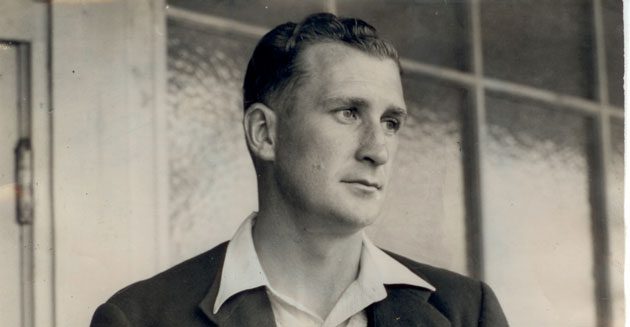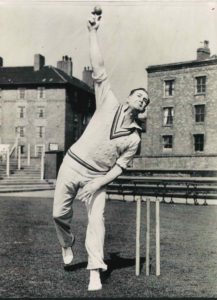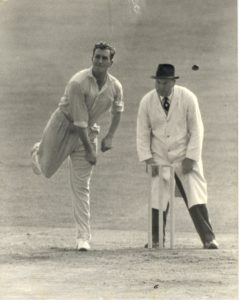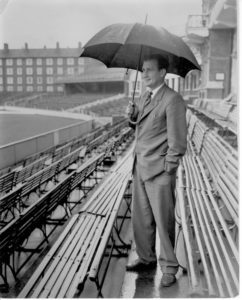James Charles Laker, one of Surrey and England’s greatest players, was born on February 9 1922. Richard Spiller pays tribute to a master of his craft.
How would Jim Laker, the greatest off-spinner in the game’s history, celebrate his centenary?
Probably in the same nonchalant manner he exhibited after completing the astonishing feat of claiming 19 Australian wickets in the Old Trafford Test on 1956.
Hugging and high fives were still a generation away but even for its time, Laker’s steady walk off the field with sweater thrown over his shoulder, having trapped Len Maddocks LBW to finish with 19-90 – a feat never achieved before or since – underlined his innate modesty.
Yet there was little about his career which deserved that diffidence. Born in Shipley, Yorkshire, he took 193 Test wickets at 21 apiece in his 46 Tests – it would have been many more but for the strength of competition and fickleness of selectors – while in the first-class game he enjoyed a haul of 1,944 victims at 18 in 450 matches.
Alongside left-arm spinner Tony Lock plus the swing and seam of Alec Bedser – among others – Laker was a key member of the attack which saw Surrey win seven successive County Championship titles between 1952 and 1958 and the highly successful England team of that decade.
Laker was also a good enough batsman to hit two centuries and he took 270 catches, a member of the cordon which was so crucial to Surrey’s success.
His mastery earned him worldwide respect, spinning the ball so hard that batsmen and fielders could hear it buzzing in flight.
MICKY’S THOUGHTS
Long-time Surrey team-mate Micky Stewart explained Laker’s skills in his book Micky Stewart and the changing face of cricket.
“To me, Jim was an absolute artist. His control was immaculate and the spin he imparted was incredible.
“I fielded at short-leg, either as bat-pad or forward close in, and I could hear the snap of his fingers followed by the zzzzzz of the ball coming down the pitch. My forward position was really ‘bomb alley’ but such was Jim’s accuracy that I never felt in any danger.”
England colleague Colin Cowdrey agreed, describing Laker as “perhaps the best off-spinner the game has seen” while Garry Sobers, one of his most illustrious opponents, added that he was “undoubtedly the best off-spinner I ever saw”
KEY CAREER MOMENTS
1946: Posted to the War Office, having served in the Middle East during the Second World War, Laker was living in Catford and impressed the local club’s president, Andrew Kempton, who recommended him to Surrey. With his native Yorkshire offering no objection – a move they later regretted – he was offered a trial by Surrey and made his first-class debut against Combined Services in July, claiming 3-43 in the first innings. Two more matches added to the good impression and he was offered professional terms on being demobbed.
1948: Having claimed 79 first-class wickets in his first full season, Laker was picked for England’s tour of West Indies in 1947-48, an experimental side beaten 2-0. The Surrey off-spinner was regarded as one of the few successes and he marked his Test debut at the Kensington Oval in Barbados by claiming 7-103 in the first innings.
1950: Harshly treated by Donald Bradman’s Australian ‘Invincibles’ in the 1948 Ashes – he was heavily criticised for not bowling them out at Headingley on a turning pitch, despite having chances off his bowling missed – Laker had been largely ignored since. But in the build-up to the following winter’s Ashes, a Test Trial was staged at Bradford, five miles from his birthplace.
The pitch had been left open to the conditions, as was the custom then, a stiff wind blowing across Park Avenue to dry the top. Laker recognised conditions familiar from his youth and was savagely effective, the turn and lift he extracted earning him a remarkable 8-2 from 14 overs. County colleague Eric Bedser was gifted one off the mark and Fred Trueman inside-edged the other, England going on to win by an innings and 89 runs.
1951: That Bradford haul could not earn Laker more than one Test in 1950 – he was hampered by a hand injury – and despite claiming 155 first-class wickets in helping Surrey share the County Championship title with Lancashire, he was ignored for the Australian tour. But he returned the following summer and in the final Test against South Africa at The Oval he claimed 4-64 and 6-55, England winning the match by four wickets and the series 3-1, strengthening his case to be one of Wisden’s five cricketers of the year the following spring.
1952: Laker’s 86 wickets were part of an attack featuring Alec Bedser (102), Eric Bedser (56), Tony Lock (116) and Stuart Surridge (68) which earned Surrey their first outright Championship title since 1914, a pennant they monopolise until 1958.
1953: Recalled for the final three Tests of the Ashes series, Laker’s 4-75 – alongside Lock’s 5-45 – bowled out Australia cheaply at The Oval as Len Hutton’s England side won the series and reclaim the urn after 19 years.
1956: Harshly treated in the Caribbean in 1953-54 and restricted to one Test in each of the following two summers – having been ignored for the Australian tour in between – Laker was still far from an automatic selection at the age of 34, even though he proved consistently devastating for Surrey.
The best was yet to come, though, ignited by claiming all 10 wickets in Australia’s first innings when the played Surrey at The Oval in May. He finished with 10-88 from 46 overs – emulating Ted Barrett’s clean sweep in 1878 – which earned victory by 10 wickets and for the first time in his career Laker appears in all five Tests that summer. Australia’s struggles against him reached their nadir at Old Trafford, where he proved unplayable in taking 9-37 and 10-53 to make cricket history and ensure the Ashes were retained. He took 46 wickets in the series and became the first cricketer to be named as the BBC’s sports personality of the year.
1957: Now the undisputed first choice for England, Laker enjoyed a successful tour of South Africa in 1956-57 – claiming 50 wickets in all – and with Lock was in devastating form for both Surrey, champions for the sixth time in a row, and England as they hammered West Indies 3-0.
1958-59: Helping to Surrey to their remarkable seventh Championship success, Laker was finally selected for an Ashes tour although not before a row with Peter May – his captain for county and country – saw him almost pull out. Announcing he would retire at the end of the following season, his arthritic spinning finger increasingly troublesome, Laker proved England’s most effective bowler with 15 wickets in four Tests despite Australia being desperate to avenge their Old Trafford humiliation. But it was a disastrous tour for the tourists, who were thrashed 4-0. Laker’s final Test came at Melbourne, where he claimed 4-93 in the first innings and didn’t bowl in the second as England were beaten by nine wickets. The following summer, his last for Surrey, he took 72 Championship wickets as Surrey slipped to third place, his final appearance coming against Northamptonshire at The Oval in September.
It was by far from the end of Laker’s involvement in cricket, although criticism made in his autobiography Over To Me – mild by today’s standards – saw his relations with both Surrey and MCC frozen but he soon returned to the game, playing 30 matches for Essex as an amateur. It was fitting, though, that his final first-class appearance should come back at the Kensington Oval, playing for the International Cavaliers against Barbados, in 1965.
POST-PLAYING CAREER
Laker became familiar to another generation as one of the BBC’s most familiar voices of cricket, partnering Richie Benaud over many years as a cool and calm commentator who was happy to let the pictures do most of the talking. His knowledge of the game was utilised by Surrey when he became chairman of the cricket committee.
Jim Laker died on April 23 1986, aged 64, and his ashes were scattered at The Oval. His wife Lilly, who he met in Cairo during the war and married in 1951, died aged 102 in September 2021.
“When he was at his best and batsmen were hopping a round the crease as though on hot bricks, he went about his destructive work casually, as though it was all in a day’s work and the sooner the day was over the better,” wrote Sir Neville Cardus about Laker.
John Arlott, Laker’s fellow commentator over many seasons for BBC’s coverage of the Sunday League, was another admirer: “Tongue in cheek, he strolled back to his mark at his characteristic constabulary gait; he looked up to the sky as he turned and then jogged the approach he used artfully to vary, constantly changing the number of steps so as, often, to defeat the batsmen’s timing.”
No less than former Prime Minister Sir John Major spent the better part of his childhood watching the great man at The Oval, saying in 2014: “In between innings, when the wicket was swept, if the dust came up the crowd was like Romans waiting for the Christians and the Lions to be introduced, because they knew what Lock and Laker would do on that pitch.”













